Scott #116 is part of the 1869 Pictorial Issue, a series that marked a major departure from the earlier tradition of exclusively using portraits of political leaders or symbolic emblems on U.S. postage stamps. This issue combined both conventional portraits and pictorial themes, including allegorical and national symbols.
The 10-cent denomination, Scott #116, featured an eagle and shield design, underscoring national strength and unity. Issued in 1869, this stamp played a crucial role in covering specific postal rates, particularly international mail and higher-value services.
Its subject matter highlighted patriotism through a design that placed national iconography at the forefront, reflecting the country’s identity during the post-Civil War Reconstruction era.
Design & Print
Scott #116 was printed by the National Bank Note Company under contract with the Post Office Department. The stamp was produced in yellow ink on hard wove paper and impressed with the experimental “G” grill, which consisted of small square pyramids pressed into the paper in a 12 by 11 point pattern.
This feature was intended to prevent the reuse of stamps by making cancellation ink penetrate the paper fibers more thoroughly. The vignette depicts an eagle with outstretched wings perched on a shield, grasping arrows in one talon and an olive branch in the other, a familiar emblem of the United States government.
Above the eagle is a scroll with “U.S. Postage,” and below appears the denomination, “Ten Cents,” spelled out clearly. Production quantities were significantly smaller than the heavily used 3-cent Washington of the same series, reflecting the more specialized role of the 10-cent rate. The engraving was executed with precision, with special attention given to the feather details of the eagle and the ornamental background.
Postal Usage
The 10-cent denomination was primarily intended for international correspondence under existing postal treaties. In 1869, one of its key roles was covering the single-weight rate for letters sent to certain European destinations outside Great Britain.
Domestically, it was used for heavy or oversized letters and packages, or in combination with lower denominations to create exact rates for registered mail and multiple-ounce letters. Its issuance corresponded with a postal system adapting to growing international communication needs, as well as increasing demands for secure and reliable domestic services.
The denomination was high enough to make it less common in ordinary daily correspondence but indispensable for specific categories of mail.
Identification
Scott #116 is distinguished by its bright yellow color, horizontal orientation, and the eagle and shield vignette. The stamp is perforated 12, in line with the rest of the 1869 Pictorial Issue.
The presence of the “G” grill is one of its most important identifiers, appearing as a rectangular grid of small square points pressed into the paper.
The engraving of the eagle, with finely detailed feathers, arrows, olive branch, and shield stripes, provides strong diagnostic features when compared to other U.S. issues of the era. Together, the yellow coloration, grill impression, and intricate engraving confirm its identification as the 10-cent Eagle and Shield of the 1869 Pictorial series.




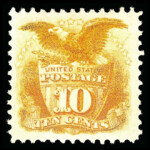
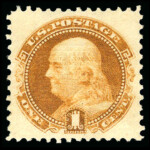
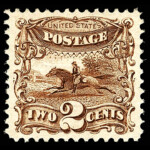
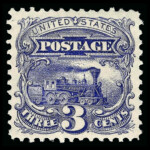
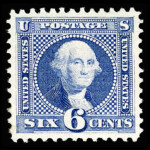
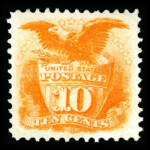

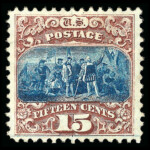
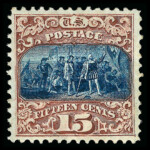

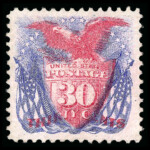













Ask A Question Or Leave A Comment